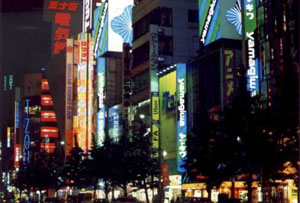

I had a bit of help when I got off the plane. I had contacted a local church that was a Vineyard church like mine before I had left, and the pastor there arranged someone to pick me up. I'm grateful, because I was rather intimidated by the transportation system of Japan. She escorted me to the youth hostel I was staying at. She was a great help, since I was completely clueless and my luggage weighed a ton. That's one thing to keep in mind: pack lightly. I tried to pack as lightly as I could, but I also had gifts for all the people I would be staying with in Japan. I picked out a basic blue suitcase which stood out from other suitcases. It was a big one with wheels. You'll need wheels, but you'll also need to be able to pick the big thing up and carry it down stairs. I was rather surprised by the lack of handicap access in most stations. Apparently they do not have the same laws as in America. Some of the bigger train stations may have an elevator or a wheelchair ramp, but not as often as I was wanting there to be. Plus I had my camera case, and I always wore a backpack in which I kept essentials wherever I went.
From Shinjuku Station, take the Odakyu Line south two stops to Sangubashi Station. Getting to the hostel isn't exactly self-explanitory. When you exit Sangubashi Station, walk up the hill until you get to the busy street. Cross at the crosswalk and go right. Don't follow the busy street, but go down the dead-end street. You will see a gate to the right with a sign that says National Olympics Memorial Youth Center. This is where the youth hostel is. This is where I stayed on the first leg of my trip.
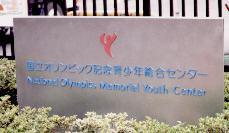
|
 I finally made it to my youth hostel. There are two big youth hostels in the Tokyo area: The Tokyo International Youth Hostel near Iidabashi Station, and the Yoyogi Youth Hostel near Sangubashi Station. I stayed at the latter. It was an excellent quality youth hostel. You get your own private room with air conditioning and the curfew is late, at 10pm.
I finally made it to my youth hostel. There are two big youth hostels in the Tokyo area: The Tokyo International Youth Hostel near Iidabashi Station, and the Yoyogi Youth Hostel near Sangubashi Station. I stayed at the latter. It was an excellent quality youth hostel. You get your own private room with air conditioning and the curfew is late, at 10pm. I'm from the Phoenix, Arizona area, and the only mass transportation we have here are buses. On top of that, I've never ridden on one before, go figure. So, I was rather intimidated with the trains and subways. But on the second day in the morning, I met an Australian guy named Kingsley. He was travelling alone as well, and he invited me to come along with him to the Ginza area. Thanks to him, I got over my fear of getting lost on the trains and subways. Actually, Tokyo is a rather convenient city for a traveller to get around to where you want to go. I read in books about a phenomenon called sushi zume, or "packed like sushi" in trains and subways. Don't worry about this. Only around rush hour in the early morning or in the late evening would you ever experience this. I experienced it only once, in Nagoya right after a Matsuri. So, don't let those travel books intimidate you like they did me.
The Ginza wasn't the big deal I thought it would be. All my travel books and my language books are all "Ginza! Ginza!" But I didn't think it was that great. I enjoyed the Sony Building, and seeing all their cool electronics on display. But right next to the Ginza area is the Imperial Palace grounds, as well as Hibiya Park. We didn't visit the park, but we looked around the Palace and surrounding garden. There's a moat that surrounds the Palace grounds where you can see swans and koi swimming around. Plus, we saw at least a dozen joggers at a time jogging around the perimeter of the Palace. We took our picture in front of the famous Nijubashi bridge you see in all those old photos, and we looked around the East Garden. It wasn't that spectacular of an experience, but it's worth seeing. We saw a procession of a horse drawn carriage with a driver wearing a big plumed hat, escorted by all these serious looking people. Must've been someone important. Maybe they went on a munchie run to the nearest 7-11. By the way, convenience stores are real popular over there. 7-11, Circle K, Am Pm, as well as native ones like Lawson Station.


That night, I took a train to see Akihabara, Tokyo's "Electric Town." This was a real sight to see. All the brilliant signs lit up the night. This was a real experience for me. Any sort of electronics imaginable was being sold in stores that lined the streets, with store clerks beckoning customers saying, "Irrashaimase!" This is where I spent a lot of money on video games and movies. It's also interesting to see all sorts of gadgets that have yet to make their way out of Japan. I was surprised to see how small their cell phones were, which made the most compact American cell phone look big.
You may have heard all sorts of rumors about eating in Japan, like paying ten dollars for a cup of coffee. You can spend a lot on food, but it's a lot easier to find cheaper restaurants. You can pay up to 1,500 yen for fancy full-course meals, but if you look around you can find food for 600 to 900 yen. If you stay at the Yoyogi YH, there's a cool ramen shop just down the street from there. Walking up the hill from the train station, turn left on the busy street and eventually to the right you'll find a nice ramen shop. While I was staying there, later on in the evening there was also a ramen peddler at the street corner. You can find all sorts of neat places to eat cheap. A word of warning, though: don't eat at American franchises like Mc Donalds and Kentucky Fried Chicken. I didn't eat at McD's because I hate their food here in America, and I wasn't about to find out what it was like in Japan. When I went to KFC, I realized that I've had better TV dinners. Think of it this way: you didn't fly all the way to Japan to eat American food. If you want American food, eat it in America. If you do eat at a place like this, go to Burger King. It's different in Japan... it has a neat 1950's ambience. But basically as the saying goes, when in Rome, do as the Romans do. If you're in Japan, just eat Japanese food. |
I went on to Ikebukero. There wasn't much there, except for Animate and K-Books, a couple of anime/manga shops. It took a long time to find them. I made my blister on my foot from the day before even worse. I ruined my white shoes in the rain, and my muscles were still sore from the day before. There was something called the Sunshine Building which was supposed to have a great view of Tokyo, but I gave up on that because I got a bit confused there. It's 60 stories tall with tons of elevators and it's supposedly full of shops, but all I found were offices. That's all I really did that day. I didn't wear proper shoes. I either fractured or just seriously hurt my small toe nearly a year before, and it's real picky about what kind of shoes I wear. I had on some Van's-type deck shoes that slip on and off easily which didn't hurt my toe. Unfortunately, they didn't offer much support and after walking around all day my feet really started to hurt. I had planned to visit Asakusa or maybe even Yokohama, but I just surrendered to my feet and went back to the hostel after a while.
The fourth day was the best day I spent in Tokyo. I was fairly well rested up and my blister on my foot had gone away. Plus it did't rain as hard. When I woke up early and studied my map of Tokyo, I saw that the Meiji Shrine was very close to the youth hostel. I decided to take the Odakyu train up to Shinjuku, and then take the Yamanote line down to Harajuku, where the main entrance of the shrine is. After breakfast (by the way, there's an all-you-can-eat breakfast buffet in the youth center; there's a map that will show you where it is), I set out. But as I was leaving the youth center's front gate, I noticed a Torii gate to the right. (Torii indicate the entrance to a Shinto temple.) I then realized that this was the back entrance to the Meiji Shrine. It was a beautiful walk through a forest which made me forget I was in the urban expanse of Tokyo. The shrine itself was kinda neat. I guess that the remains of the Meiji Emperor are contained in the shrine. I followed the road out to the main entrance and found myself at Harajuku Station.
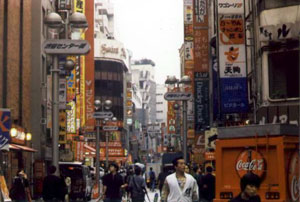
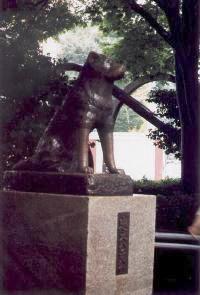 Next stop was Shibuya Station. Shibuya is a real popular shopping district for the younger crowd. I visited the Tower Records there which was about 8 stories tall. Shibuya is an amazing place to shop for clothes, music, and anything else you may need to be young and cool. On street corners, giant video screens broadcasted music videos to the pedestrians below. Other than shopping, I don't know if there is much else to see and do there. Shibuya Station has a legend I'll tell you about. Years ago, there was a faithful dog named Hachiko who walked to the station every day to wait for his master to come home from work. Hachiko must've made some friends and became very popular because when he died, the community erected a statue in his memory. The statue of Hachiko always waits outisde of the station, facing its exit. There are also Hachikos all over the wall of the station's exit in some sort of mural. As dense as I was, I missed it all. Being a silly tourist, this kind of thing was important to me, so I ended up asking some people "Hachiko wa doko desu ka?" Finally somebody pointed me to the statue, and I felt stupid. Around this statue is a popular place to meet friends. For awhile, I just studied the people passing by. Teenagers, businessmen, city employees, couples holding hands. If I wasn't in such a rush that day (and nearly every day I spent in Japan, I would have stayed around to enjoy it more. But, I moved on to my next destination.
Next stop was Shibuya Station. Shibuya is a real popular shopping district for the younger crowd. I visited the Tower Records there which was about 8 stories tall. Shibuya is an amazing place to shop for clothes, music, and anything else you may need to be young and cool. On street corners, giant video screens broadcasted music videos to the pedestrians below. Other than shopping, I don't know if there is much else to see and do there. Shibuya Station has a legend I'll tell you about. Years ago, there was a faithful dog named Hachiko who walked to the station every day to wait for his master to come home from work. Hachiko must've made some friends and became very popular because when he died, the community erected a statue in his memory. The statue of Hachiko always waits outisde of the station, facing its exit. There are also Hachikos all over the wall of the station's exit in some sort of mural. As dense as I was, I missed it all. Being a silly tourist, this kind of thing was important to me, so I ended up asking some people "Hachiko wa doko desu ka?" Finally somebody pointed me to the statue, and I felt stupid. Around this statue is a popular place to meet friends. For awhile, I just studied the people passing by. Teenagers, businessmen, city employees, couples holding hands. If I wasn't in such a rush that day (and nearly every day I spent in Japan, I would have stayed around to enjoy it more. But, I moved on to my next destination.
 Next I went to Askusa, taking the subway from Ueno Station to Asakusa. Remember that you don't really pronounce the "u" in Asakusa. This has to be the coolest place in Tokyo I visited. This is the home of the Kannon Temple. Its entrance is marked by the Kaminari Mon, a huge red lantern. There's so much to do here, plus it's surrounded by shops. For all my fellow Miyazaki fans, right next to the entrance gate is a shop that sells all sorts of neat Miyazaki collectibles. It's a great place to stock up on lots of Totoro stuff. I bought a Jiji doll here. When you pass through the gate and under the huge red lantern, you'll find yourself in the Nakamise, a long walk with shops lining the sides. Here you will find all sorts of spiffy things that only a tourist could appreciate: postcards, toys, fans, ceramics, miniatures of the Kaminari Mon, and even those silly spoons that so many people collect. At the end of the walk, there are food vendors. Here I ate some yakisoba noodles and yakitori (barbecued chicken on a stick). Then there's another huge red lantern, and the entrance to the temple.
Next I went to Askusa, taking the subway from Ueno Station to Asakusa. Remember that you don't really pronounce the "u" in Asakusa. This has to be the coolest place in Tokyo I visited. This is the home of the Kannon Temple. Its entrance is marked by the Kaminari Mon, a huge red lantern. There's so much to do here, plus it's surrounded by shops. For all my fellow Miyazaki fans, right next to the entrance gate is a shop that sells all sorts of neat Miyazaki collectibles. It's a great place to stock up on lots of Totoro stuff. I bought a Jiji doll here. When you pass through the gate and under the huge red lantern, you'll find yourself in the Nakamise, a long walk with shops lining the sides. Here you will find all sorts of spiffy things that only a tourist could appreciate: postcards, toys, fans, ceramics, miniatures of the Kaminari Mon, and even those silly spoons that so many people collect. At the end of the walk, there are food vendors. Here I ate some yakisoba noodles and yakitori (barbecued chicken on a stick). Then there's another huge red lantern, and the entrance to the temple.
Once you get to the actual temple, there's not much point in hanging around for long unless you're a Buddhist or something. It's interesting to see what kind of stuff Buddhists do. I saw a big kettle with steam coming out of it, and people were fanning the steam onto themselves. Maybe it gives them good health or luck or something. I'm not superstitious, and it was plenty humid as it was, so I just moved on. Oh, and there's tons of pigeons there. I don't know why I had to say that, but I just thought I'd throw a non-sequitir at you. Surrounding the temple, there is a network of shopping alleys lined with stores to walk around.
On Saturday, I packed up and left for Tokorozawa, where the Vineyard church I had been in contact is. I was offered to stay with an American guy named Jamie who taught English there, and he met me at the train station. I was told that Tokorozawa was the rural setting for the Miyazaki movie "Tonari no Totoro." Well, Tokorozawa is certainly no longer rural. I met Pastor Araki at the church, as well as a lady named Yuri who spoke fluent English. Actually, quite a few people at the church are fluent in English. I spent the rest of the day with Jamie and Yuri in the church building. After awhile, it was like I had forgotten that I was in Japan. I had to go over to the window to remind myself that I had come all this way to the country. I pointed outside and said, "Oh look! There's Japan out there. Neat!" They probably thought I was strange.
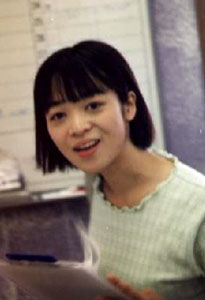 The next morning, I met more people from the church. Everyone there was excellent. At this point I'd like to point out something that some travellers to Japan may not be aware of. The first day I arrived in Japan, while on the trains I noticed some people glancing at me. Later on, I encountered some people who literally stared at me and it made me feel very uncomfortable. I had to remind myself that even Tokyo is not as racially diverse as is Phoenix where I am from, and especially Los Angeles. I'm sure plenty of people where I live and even I sometimes make special notice of foreigners at times, and they are much less conspicuous here than I was in Japan. Furthermore, I certainly wouldn't want people to make blanket judgements on Americans as a whole based on the behaviors of some individuals. But at the same time, it was hard not to take it personal when I'd have plenty of room next to me on seats of trains and subways because several people would prefer to stand up rather than sit next to me. But as my father often says, "Most people don't give a crap about you, so there's no point in taking things personal. The opinions of those you love are the most important." And I think it's true. But I can't say all of this without pointing out that I really had no problem getting help whenever I needed it, and that there were some people who went out of their way to be friendly to me. The general impression I received by the end of my vacation is that most Japanese people don't mind foreigners at all, and in fact they wouldn't mind getting to know one. But many might be self-conscious of their English abilities, and they don't know how to approach foreigners without them initiating the conversation. And I must say that everyone at the Vineyard church of Tokorozawa was so friendly, and they weren't afraid to meet me. I'd say that the best people in Japan I met were Christians.
The next morning, I met more people from the church. Everyone there was excellent. At this point I'd like to point out something that some travellers to Japan may not be aware of. The first day I arrived in Japan, while on the trains I noticed some people glancing at me. Later on, I encountered some people who literally stared at me and it made me feel very uncomfortable. I had to remind myself that even Tokyo is not as racially diverse as is Phoenix where I am from, and especially Los Angeles. I'm sure plenty of people where I live and even I sometimes make special notice of foreigners at times, and they are much less conspicuous here than I was in Japan. Furthermore, I certainly wouldn't want people to make blanket judgements on Americans as a whole based on the behaviors of some individuals. But at the same time, it was hard not to take it personal when I'd have plenty of room next to me on seats of trains and subways because several people would prefer to stand up rather than sit next to me. But as my father often says, "Most people don't give a crap about you, so there's no point in taking things personal. The opinions of those you love are the most important." And I think it's true. But I can't say all of this without pointing out that I really had no problem getting help whenever I needed it, and that there were some people who went out of their way to be friendly to me. The general impression I received by the end of my vacation is that most Japanese people don't mind foreigners at all, and in fact they wouldn't mind getting to know one. But many might be self-conscious of their English abilities, and they don't know how to approach foreigners without them initiating the conversation. And I must say that everyone at the Vineyard church of Tokorozawa was so friendly, and they weren't afraid to meet me. I'd say that the best people in Japan I met were Christians.It was here in Tokorozawa when I knew for sure that I wanted to spend some part of my life living and working in Japan. Up to this point I had the idea that I'd someday like to live and work in Japan as a goal/dream for my life, and that actually travelling to the country would be the true test of whether I would really want to or not. Staying with Jamie for those two short days and seeing his life as an expatriate, I could see glimpses into my own future, and I could see myself doing the same thing. Staying in Tokorozawa was a real benchmark in my life. Plus, I got to meet my dear penpal Mayu for the first time that Sunday. The next day I left for Nagoya. |
 Go back to the "Greg's Life" Table of Contents
Go back to the "Greg's Life" Table of Contents

"Crazy? What's wrong with crazy? The Romans were crazy, and they got all the girls." --The Tick